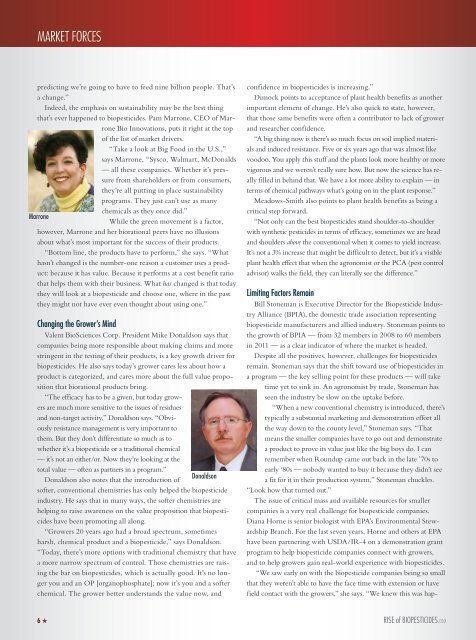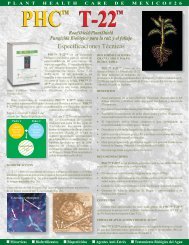The Rise of Biopesticides - BioWorks Inc.
The Rise of Biopesticides - BioWorks Inc.
The Rise of Biopesticides - BioWorks Inc.
You also want an ePaper? Increase the reach of your titles
YUMPU automatically turns print PDFs into web optimized ePapers that Google loves.
MARKET FORCES<br />
predicting we’re going to have to feed nine billion people. That’s<br />
a change.”<br />
Indeed, the emphasis on sustainability may be the best thing<br />
that’s ever happened to biopesticides. Pam Marrone, CEO <strong>of</strong> Marrone<br />
Bio Innovations, puts it right at the top<br />
<strong>of</strong> the list <strong>of</strong> market drivers.<br />
“Take a look at Big Food in the U.S.,”<br />
says Marrone, “Sysco, Walmart, McDonalds<br />
— all these companies. Whether it’s pressure<br />
from shareholders or from consumers,<br />
they’re all putting in place sustainability<br />
programs. <strong>The</strong>y just can’t use as many<br />
chemicals as they once did.”<br />
Marrone<br />
While the green movement is a factor,<br />
however, Marrone and her biorational peers have no illusions<br />
about what’s most important for the success <strong>of</strong> their products.<br />
“Bottom line, the products have to perform,” she says. “What<br />
hasn’t changed is the number-one reason a customer uses a product:<br />
because it has value. Because it performs at a cost benefit ratio<br />
that helps them with their business. What has changed is that today<br />
they will look at a biopesticide and choose one, where in the past<br />
they might not have ever even thought about using one.”<br />
Changing the Grower’s Mind<br />
Valent BioSciences Corp. President Mike Donaldson says that<br />
companies being more responsible about making claims and more<br />
stringent in the testing <strong>of</strong> their products, is a key growth driver for<br />
biopesticides. He also says today’s grower cares less about how a<br />
product is categorized, and cares more about the full value proposition<br />
that biorational products bring.<br />
“<strong>The</strong> efficacy has to be a given, but today growers<br />
are much more sensitive to the issues <strong>of</strong> residues<br />
and non-target activity,” Donaldson says. “Obviously<br />
resistance management is very important to<br />
them. But they don’t differentiate so much as to<br />
whether it’s a biopesticide or a traditional chemical<br />
— it’s not an either/or. Now they’re looking at the<br />
total value — <strong>of</strong>ten as partners in a program.”<br />
Donaldson also notes that the introduction <strong>of</strong><br />
Donaldson<br />
s<strong>of</strong>ter, conventional chemistries has only helped the biopesticide<br />
industry. He says that in many ways, the s<strong>of</strong>ter chemistries are<br />
helping to raise awareness on the value proposition that biopesticides<br />
have been promoting all along.<br />
“Growers 20 years ago had a broad spectrum, sometimes<br />
harsh, chemical product and a biopesticide,” says Donaldson.<br />
“Today, there’s more options with traditional chemistry that have<br />
a more narrow spectrum <strong>of</strong> control. Those chemistries are raising<br />
the bar on biopesticides, which is actually good. It’s no longer<br />
you and an OP [organophosphate]; now it’s you and a s<strong>of</strong>ter<br />
chemical. <strong>The</strong> grower better understands the value now, and<br />
confidence in biopesticides is increasing.”<br />
Dimock points to acceptance <strong>of</strong> plant health benefits as another<br />
important element <strong>of</strong> change. He’s also quick to state, however,<br />
that those same benefits were <strong>of</strong>ten a contributor to lack <strong>of</strong> grower<br />
and researcher confidence.<br />
“A big thing now is there’s so much focus on soil implied materials<br />
and induced resistance. Five or six years ago that was almost like<br />
voodoo. You apply this stuff and the plants look more healthy or more<br />
vigorous and we weren’t really sure how. But now the science has really<br />
filled in behind that. We have a lot more ability to explain — in<br />
terms <strong>of</strong> chemical pathways what’s going on in the plant response.”<br />
Meadows-Smith also points to plant health benefits as being a<br />
critical step forward.<br />
“Not only can the best biopesticides stand shoulder-to-shoulder<br />
with synthetic pesticides in terms <strong>of</strong> efficacy, sometimes we are head<br />
and shoulders above the conventional when it comes to yield increase.<br />
It’s not a 3% increase that might be difficult to detect, but it’s a visible<br />
plant health effect that when the agronomist or the PCA (pest control<br />
advisor) walks the field, they can literally see the difference.”<br />
Limiting Factors Remain<br />
Bill Stoneman is Executive Director for the Biopesticide Industry<br />
Alliance (BPIA), the domestic trade association representing<br />
biopesticide manufacturers and allied industry. Stoneman points to<br />
the growth <strong>of</strong> BPIA — from 32 members in 2008 to 60 members<br />
in 2011 — as a clear indicator <strong>of</strong> where the market is headed.<br />
Despite all the positives, however, challenges for biopesticides<br />
remain. Stoneman says that the shift toward use <strong>of</strong> biopesticides in<br />
a program — the key selling point for these products — will take<br />
time yet to sink in. An agronomist by trade, Stoneman has<br />
seen the industry be slow on the uptake before.<br />
“When a new conventional chemistry is introduced, there’s<br />
typically a substantial marketing and demonstration effort all<br />
the way down to the county level,” Stoneman says. “That<br />
means the smaller companies have to go out and demonstrate<br />
a product to prove its value just like the big boys do. I can<br />
remember when Roundup came out back in the late ’70s to<br />
early ‘80s — nobody wanted to buy it because they didn’t see<br />
a fit for it in their production system,” Stoneman chuckles.<br />
“Look how that turned out.”<br />
<strong>The</strong> issue <strong>of</strong> critical mass and available resources for smaller<br />
companies is a very real challenge for biopesticide companies.<br />
Diana Horne is senior biologist with EPA’s Environmental Stewardship<br />
Branch. For the last seven years, Horne and others at EPA<br />
have been partnering with USDA/IR-4 on a demonstration grant<br />
program to help biopesticide companies connect with growers,<br />
and to help growers gain real-world experience with biopesticides.<br />
“We saw early on with the biopesticide companies being so small<br />
that they weren’t able to have the face time with extension or have<br />
field contact with the growers,” she says. “We knew this was hap-<br />
6 ★ RISE <strong>of</strong> BIOPESTICIDES.com



